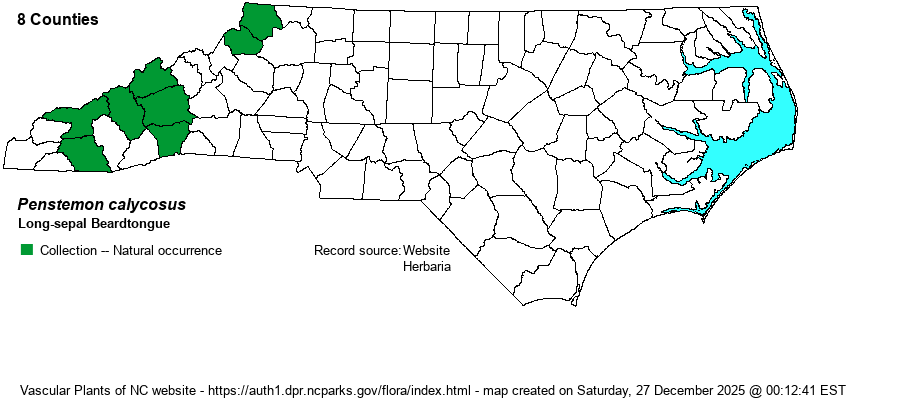| Author | Small | |
| Distribution | Poorly known and definitely overlooked, seems to be scattered across most of the Mountains. Records for eight counties in the province, though many are from the USDA map, which the editors cannot verify for specimen accuracy; five of these counties are documented with SERNEC specimens. Does not occur downstate.
This is essentially a species of the Ohio and Tennessee river valley region, west of the Appalachians. It ranges from OH and eastern IA south to northern AL. VA has only two county records, NC eight, and SC and GA only one or two each. Thus, there is a chance that locations east of this main range are possibly not native, though Weakley (2018) considers the species as native in all of these. | |
| Abundance | Rare in the Mountains, but more data and exploration are needed for this species. It was not listed in NC when RAB (1968) was published. Either the records are more recent, the specimens have been included under another species, or the specimens were overlooked in other herbaria, but this is not certain. This species is now on the Watch List, as of 2024. | |
| Habitat | In NC, this is believed to be a species mostly of dry to dry-mesic open woods and woodland borders. In VA, the species is limited to dry or rocky woods over calcareous rock material. However, in NC, details of the habitats are not clear, at least in determining an affinity to high pH soils. | |
| Phenology | Blooms from May to July, and fruits shortly after flowering. | |
| Identification | This is a medium-sized herb, typical of other Penstemon species, in being mostly unbranched and with a scattering of pairs of opposite stem leaves. This species and the widespread P. laevigatus are the only ones that are smooth (glabrous) n the upper and middle stem (between the upper sets of leaves). The leaves are a bit variable up and down the stem, but they all have strongly rounded, sessile bases that clasp the stem; some are quite widely lanceolate to ovate and can be up to 1.5 inches wide, but others are more oblong or lanceolate and narrower; all are slightly serrated. In this species, the undersides of the leaves are essentially glabrous, as is P. laevigatus. Both of these two have the upper lobes of the flowers about equaling the lower lobes, and thus the flower is squared-off from the side; in about all others, the lower lobes project farther than do the upper lobes. The latter species has smaller flowers -- about 3/4-inch long -- than does P. calycosus, which has flowers mostly about 1.3 inches long, plus P. calycosus has brighter purple-rose flowers as opposed to a pinker flower color. It has long calyx lobes, being 5.5-8 mm (about 1/4-inch) long, whereas those of P. laevigatus are 3.5-5 mm = 1/6-inch long. The inflorescence is like others in the genus, with numerous horizontally aligned flowers in clusters at the top of the stem, they being larger than most other species. Though a common to abundant meadow and woodland border species from TN westward, it is poorly known east of that state. | |
| Taxonomic Comments | None, though it is possible, if not likely, that some NC specimens had been placed within other species in the past.
| |
| Other Common Name(s) | Calico Beardtongue | |
| State Rank | S1? | |
| Global Rank | G5 | |
| State Status | W7 | |
| US Status | | |
| USACE-agcp | FACU link |
| USACE-emp | UPL link |

